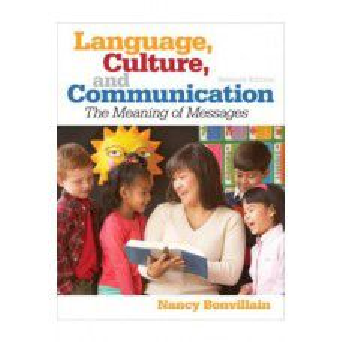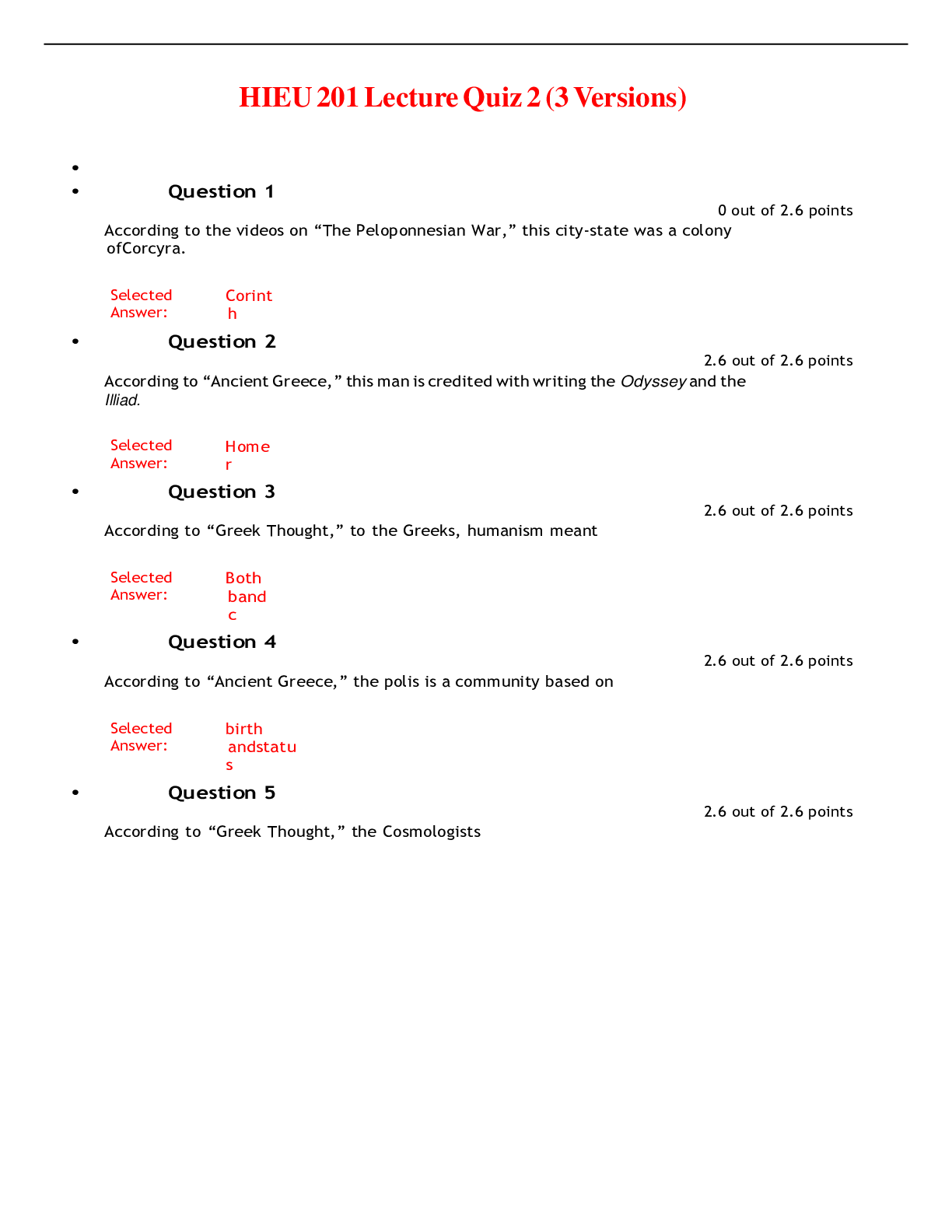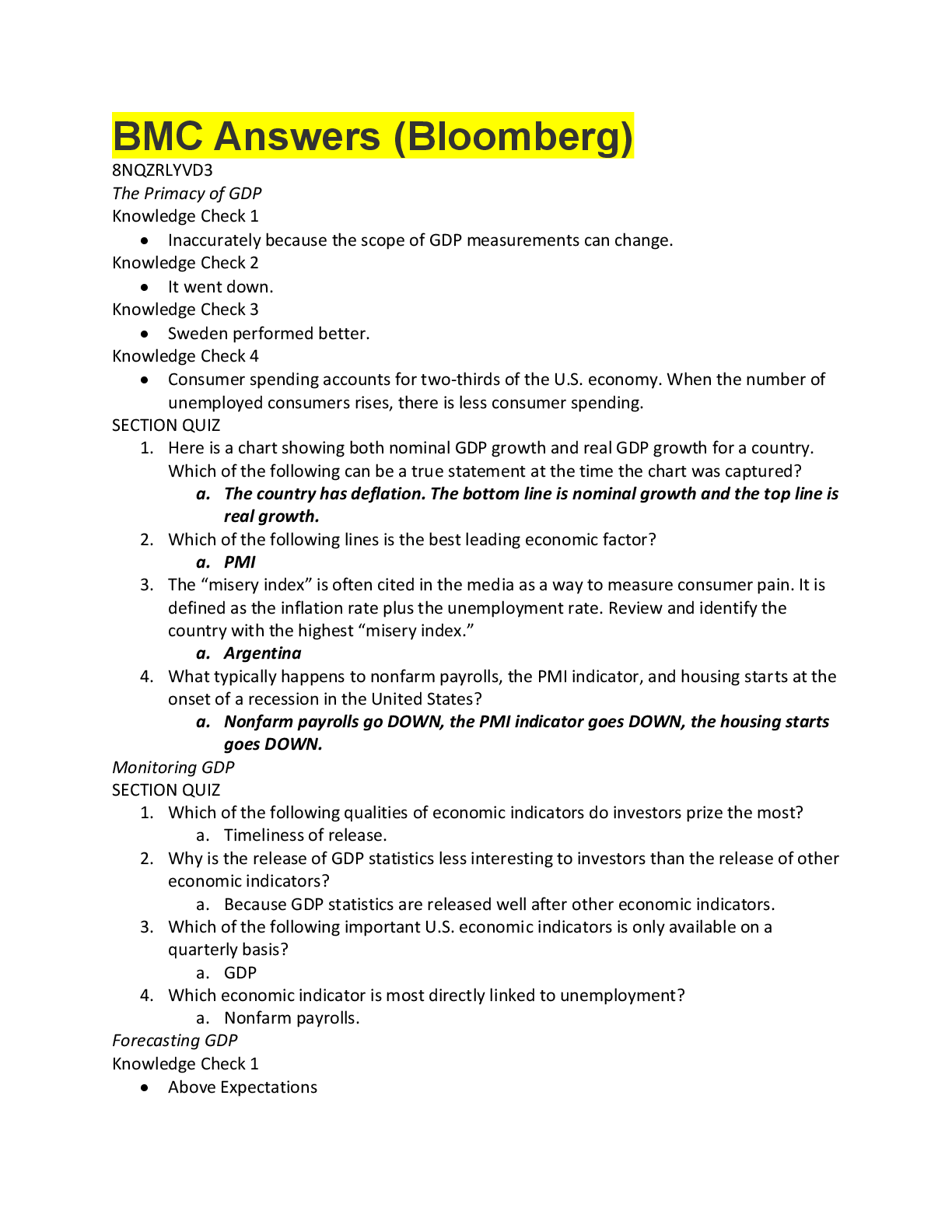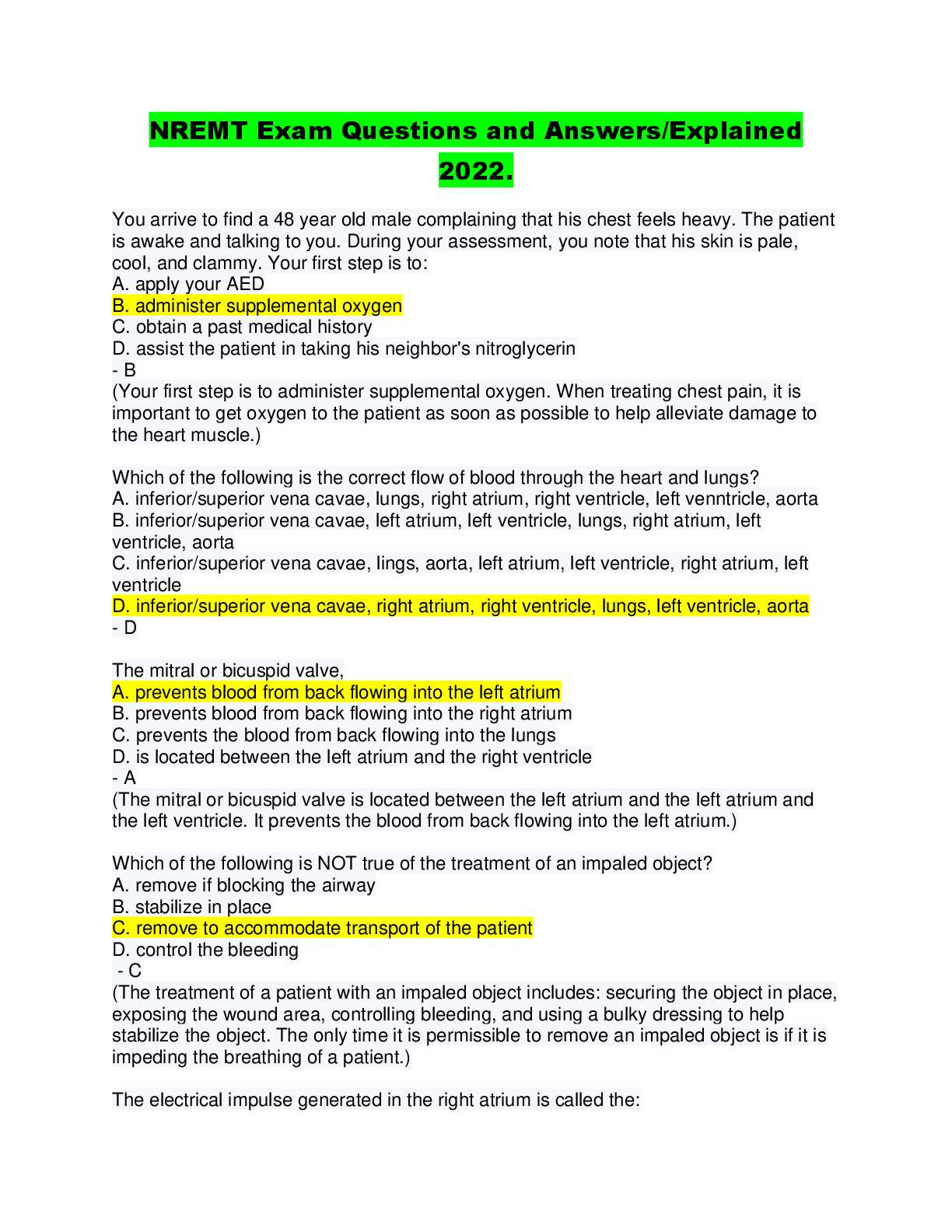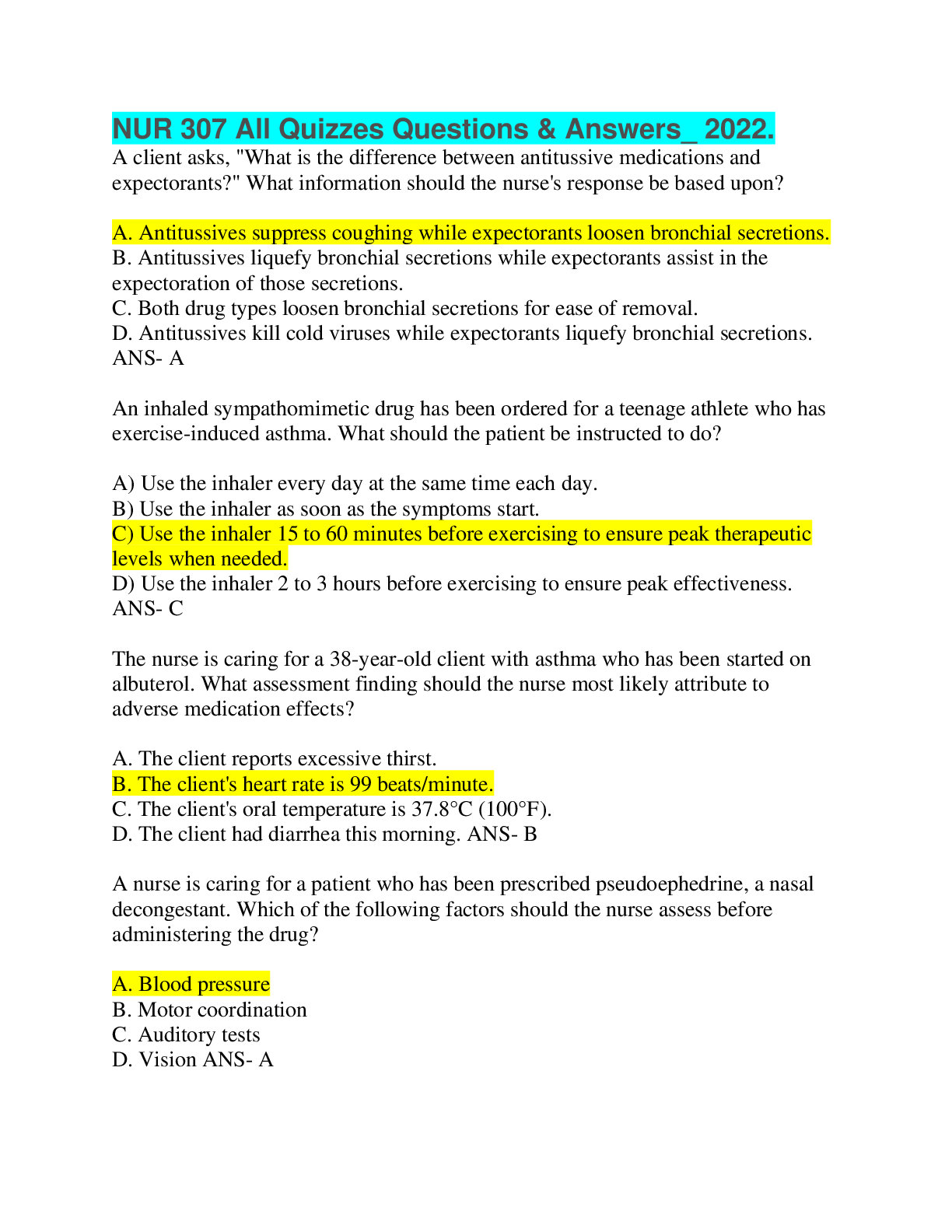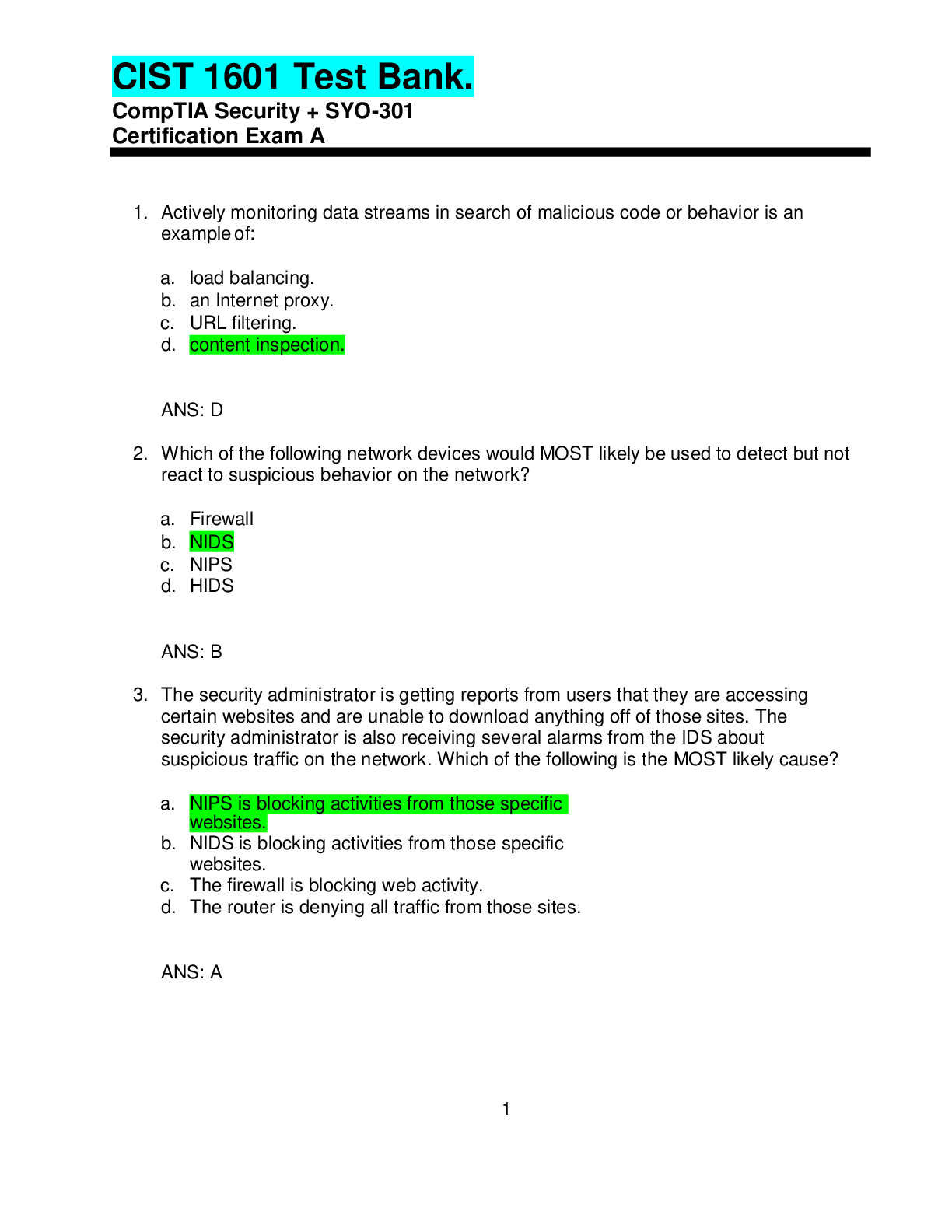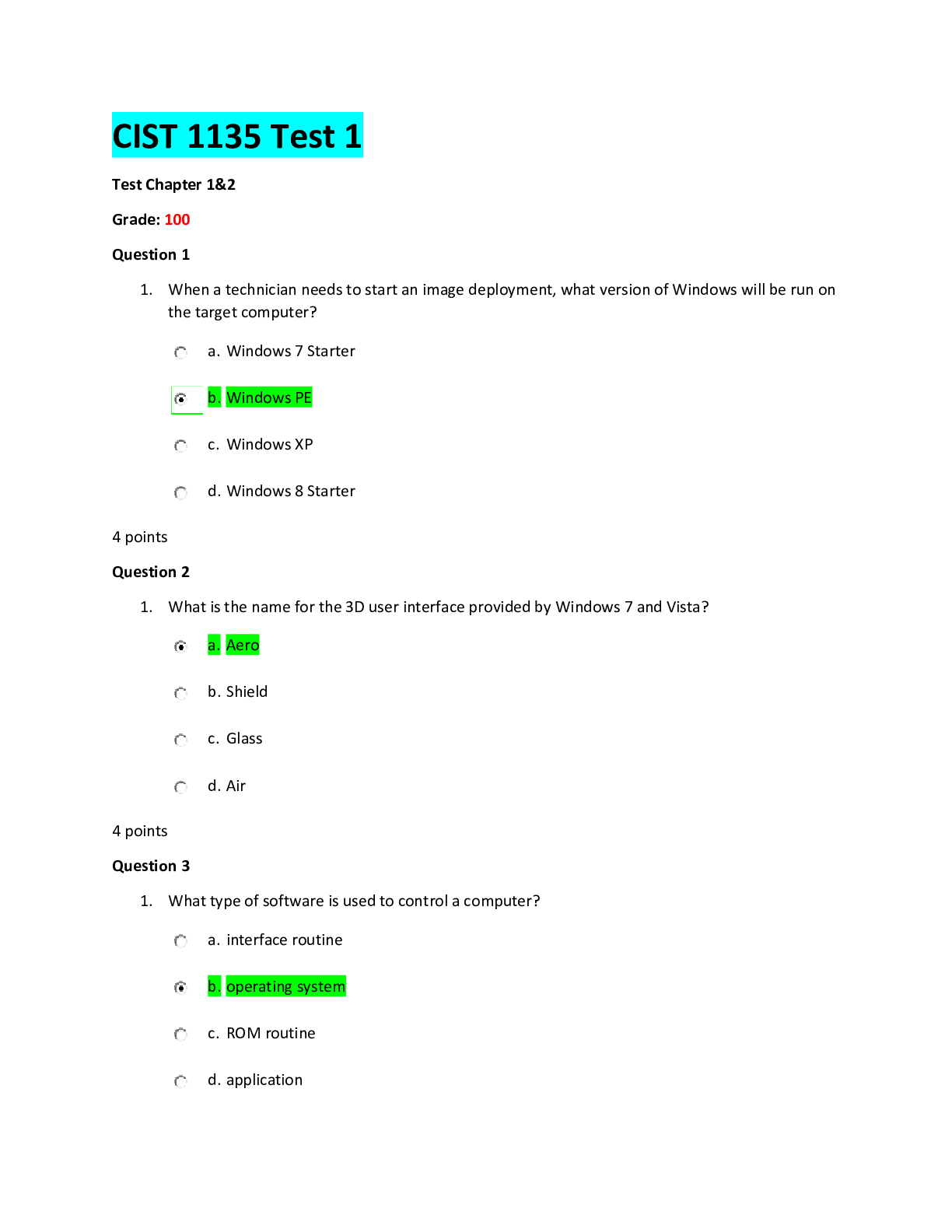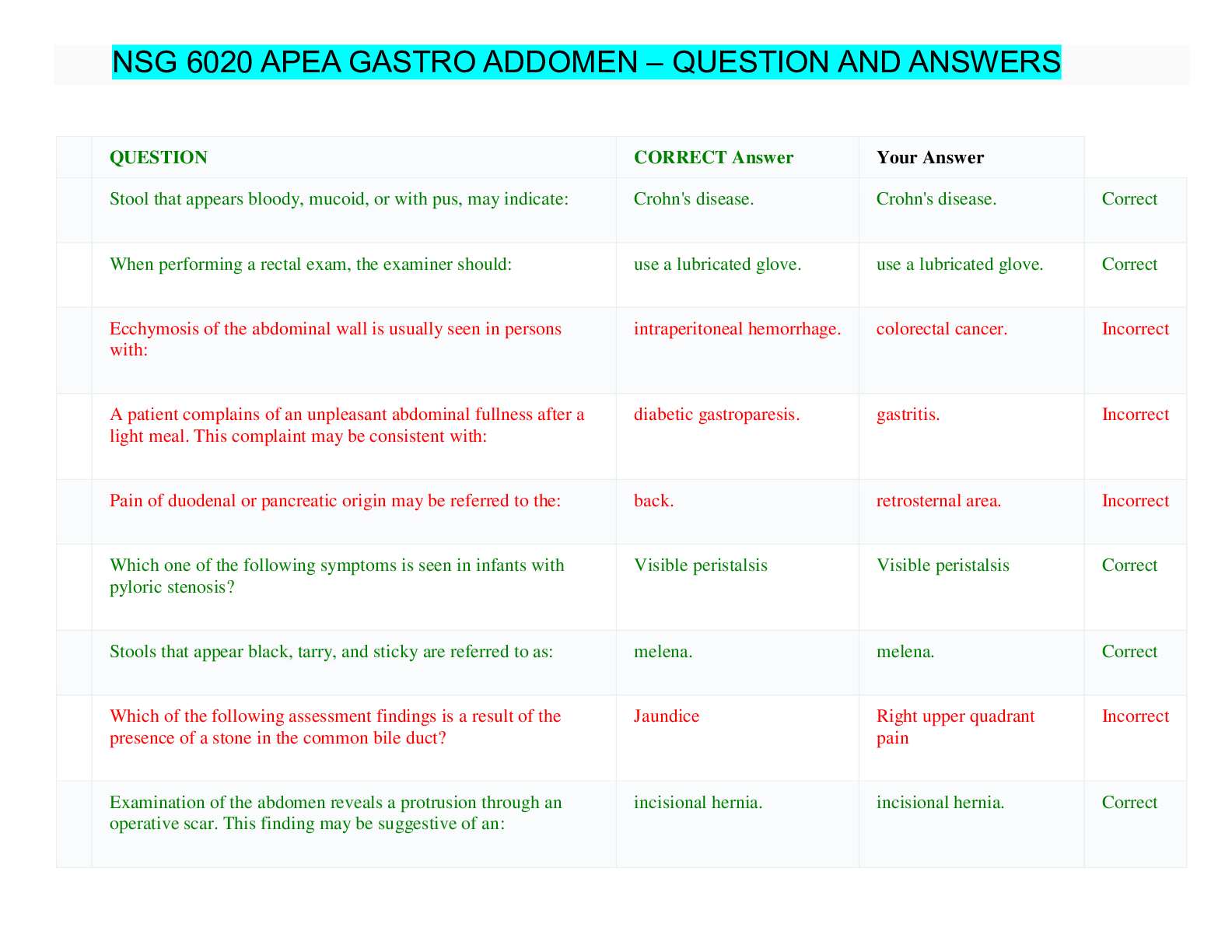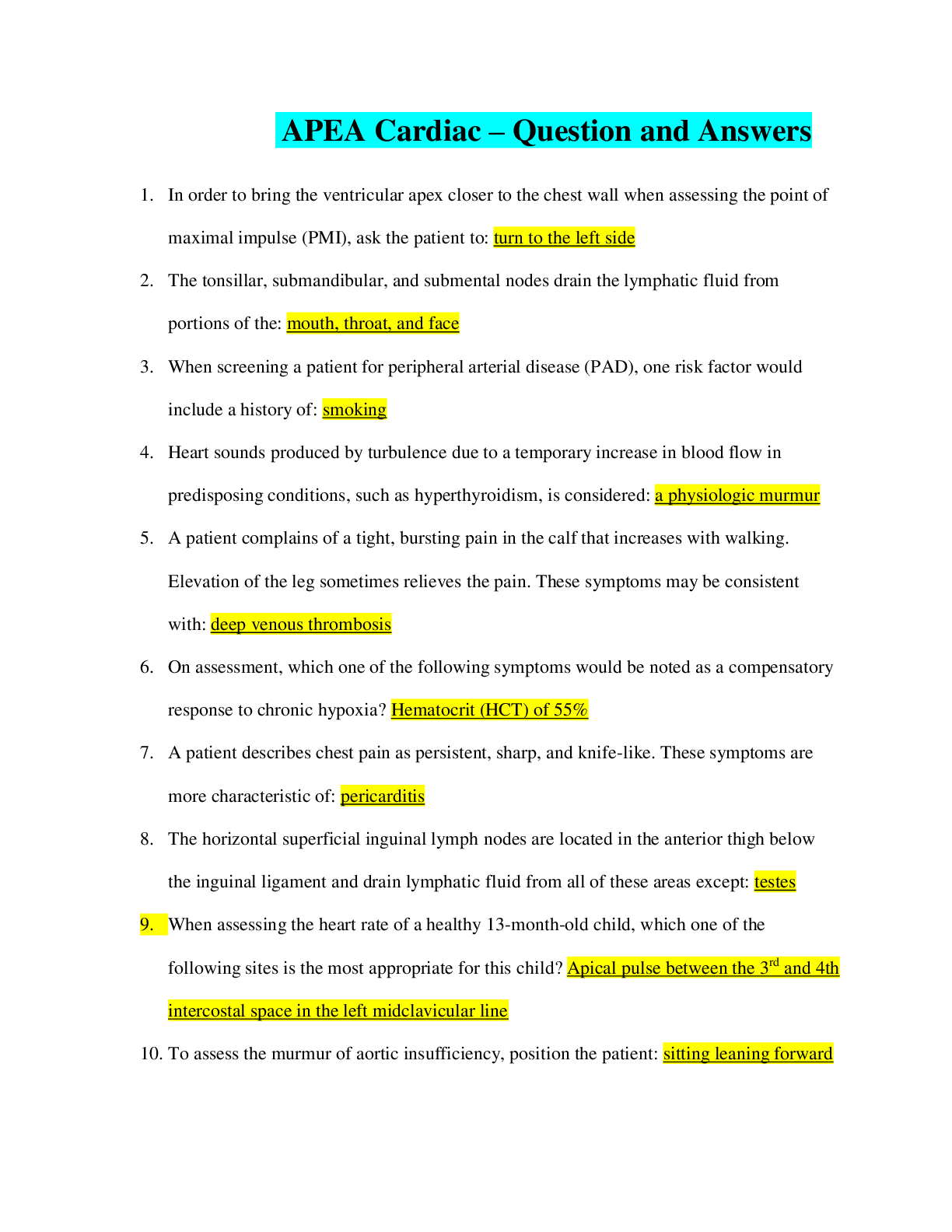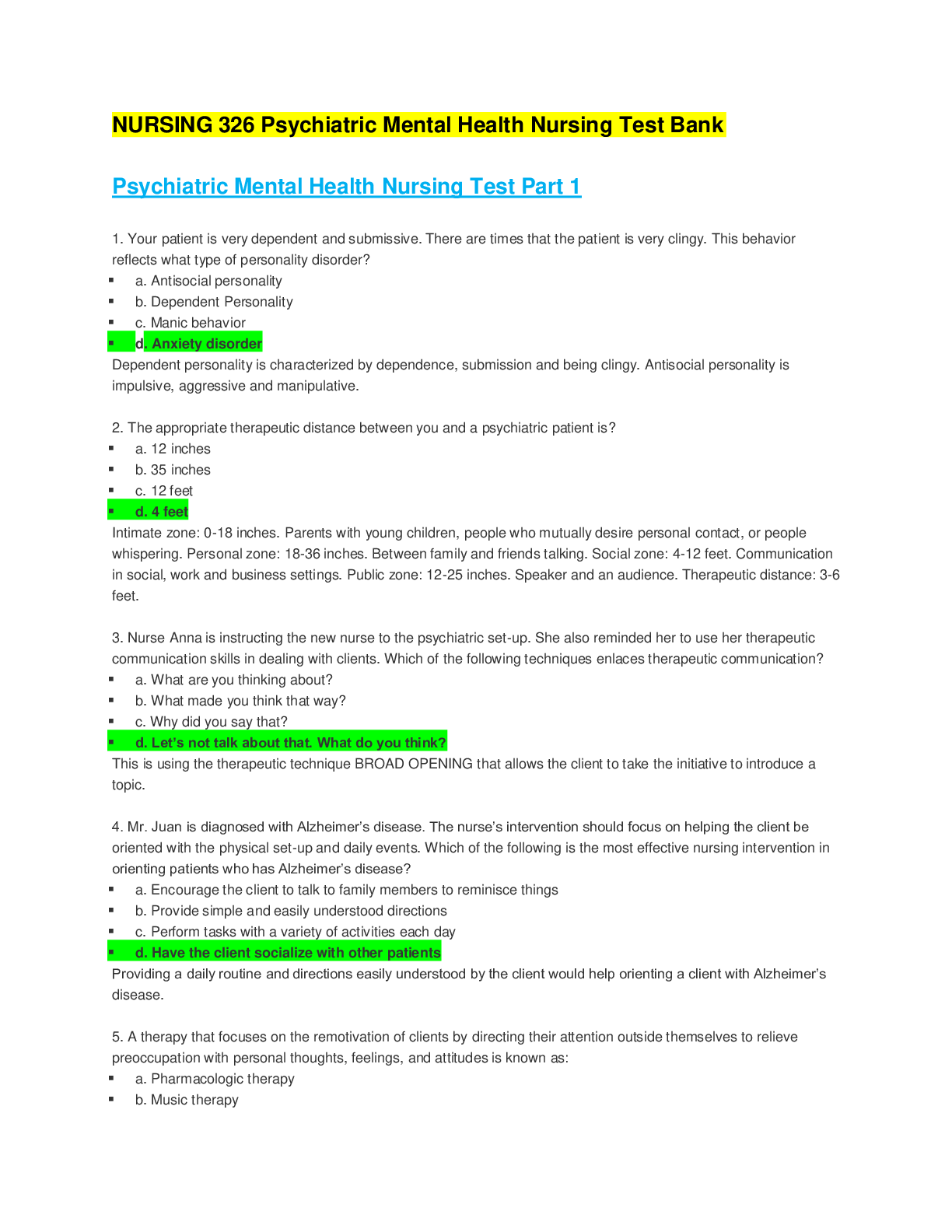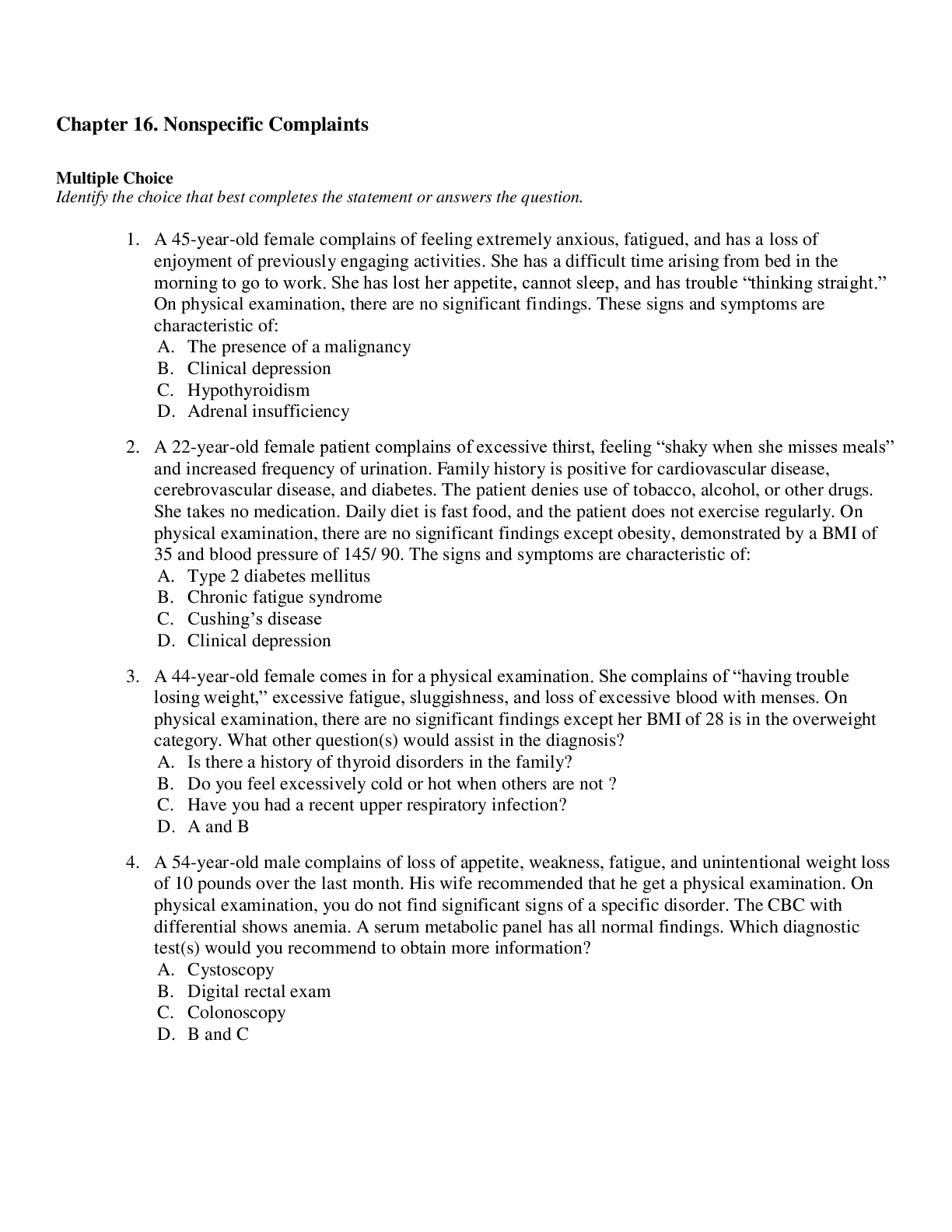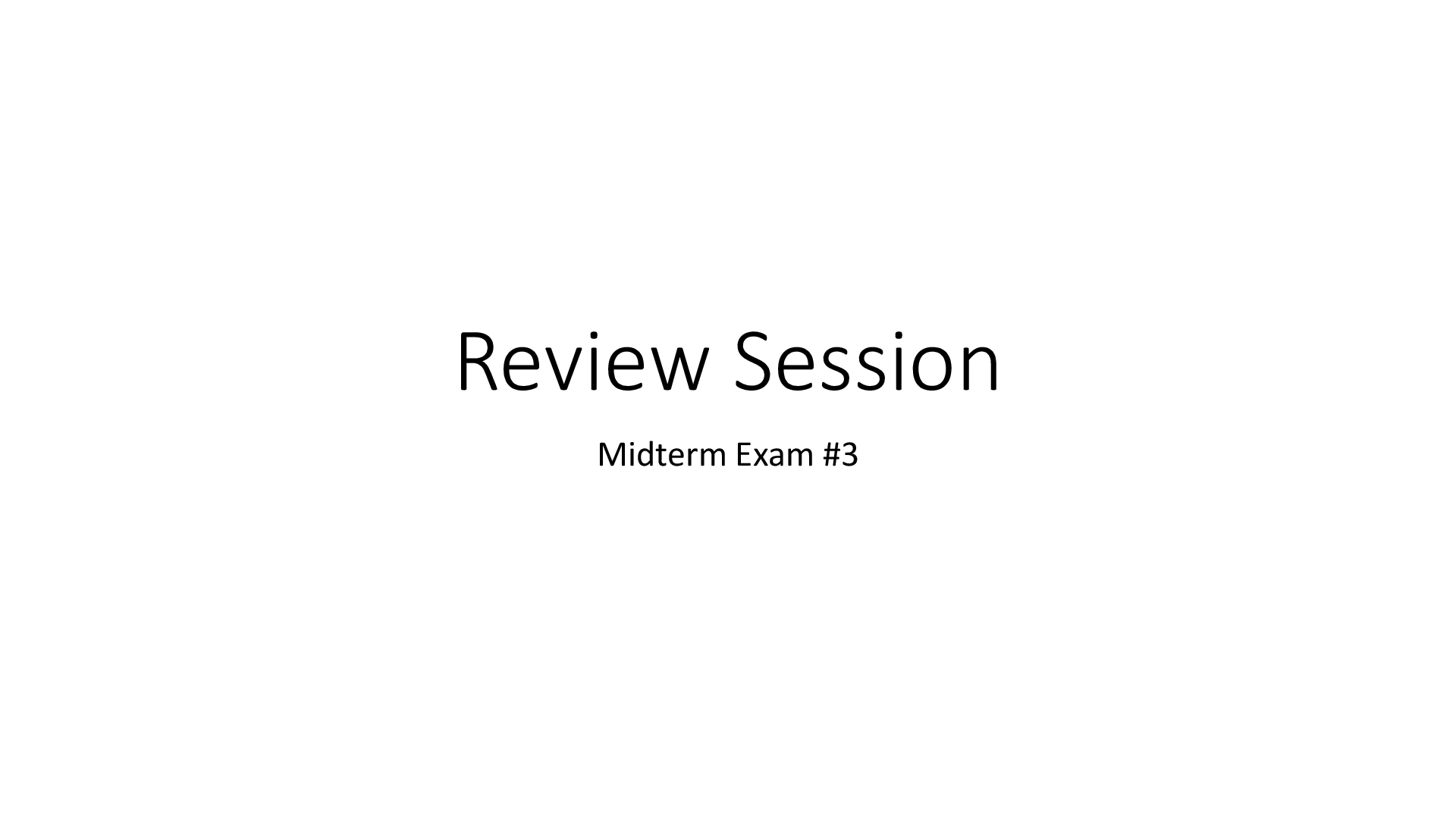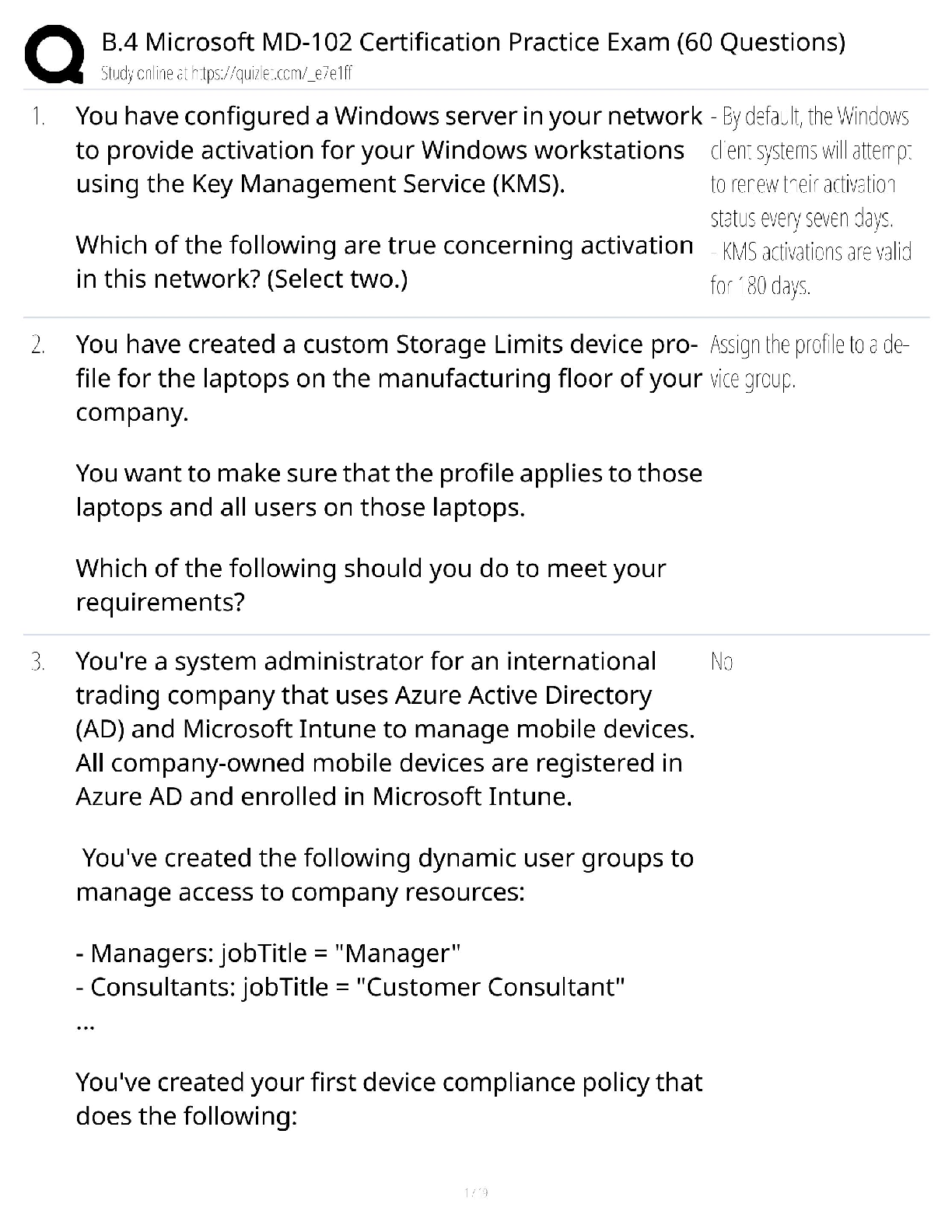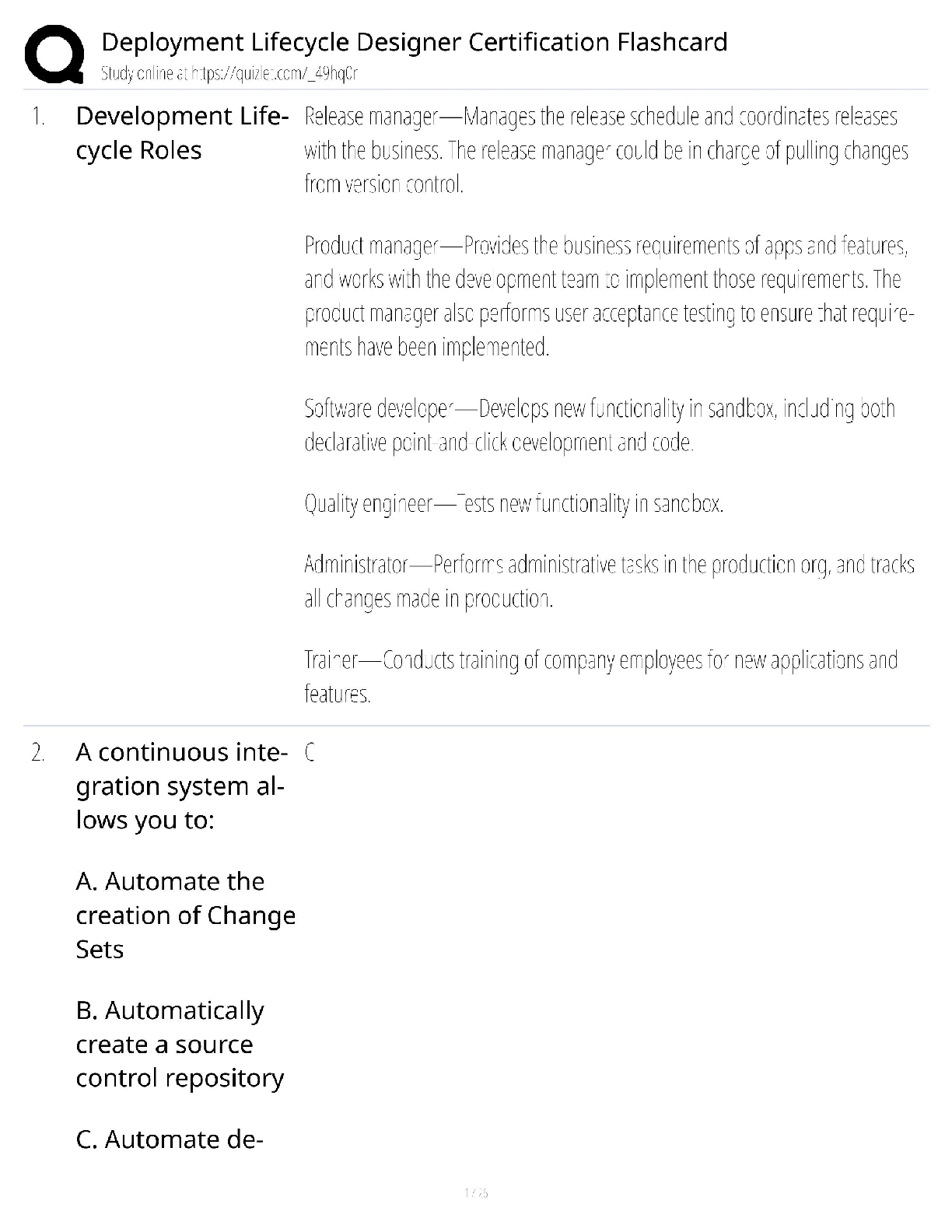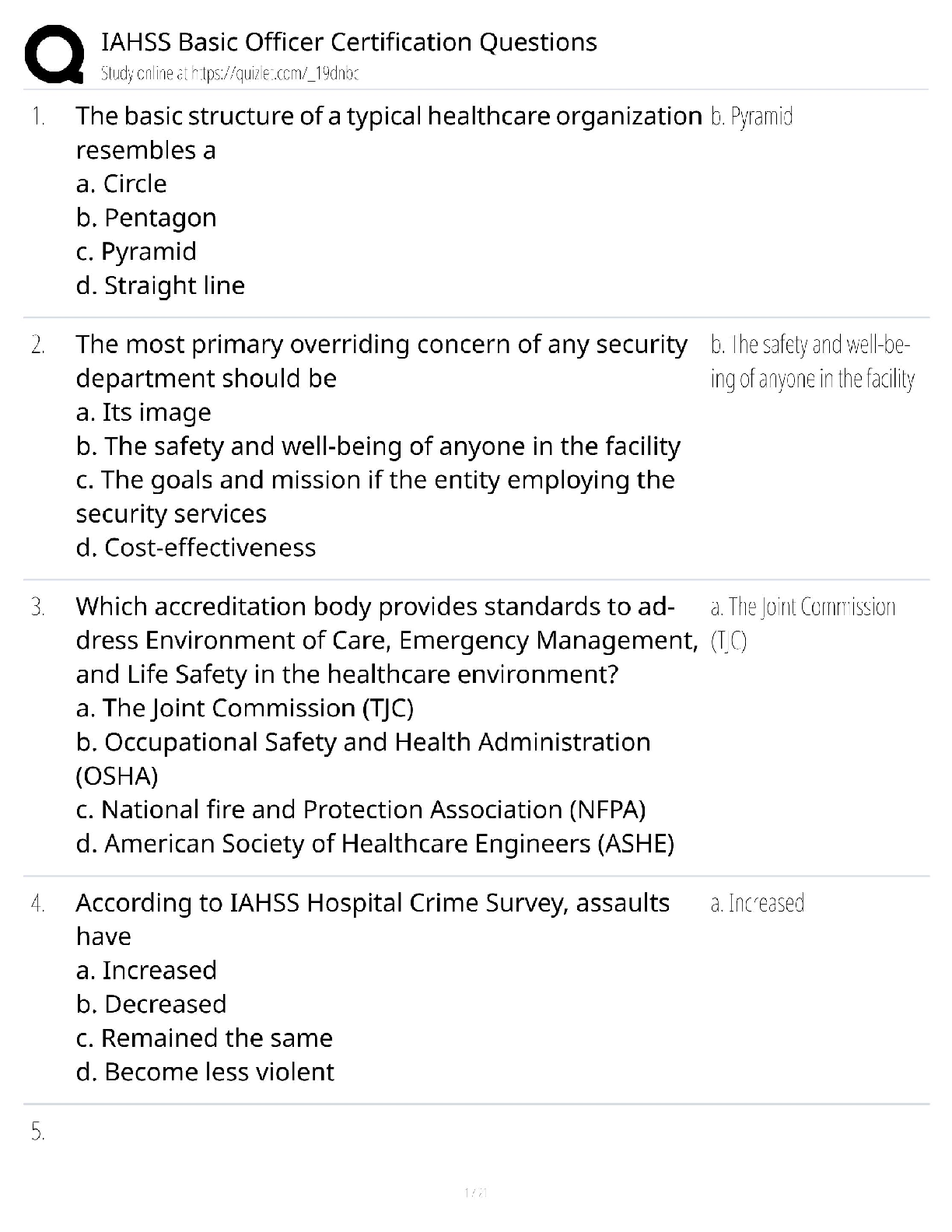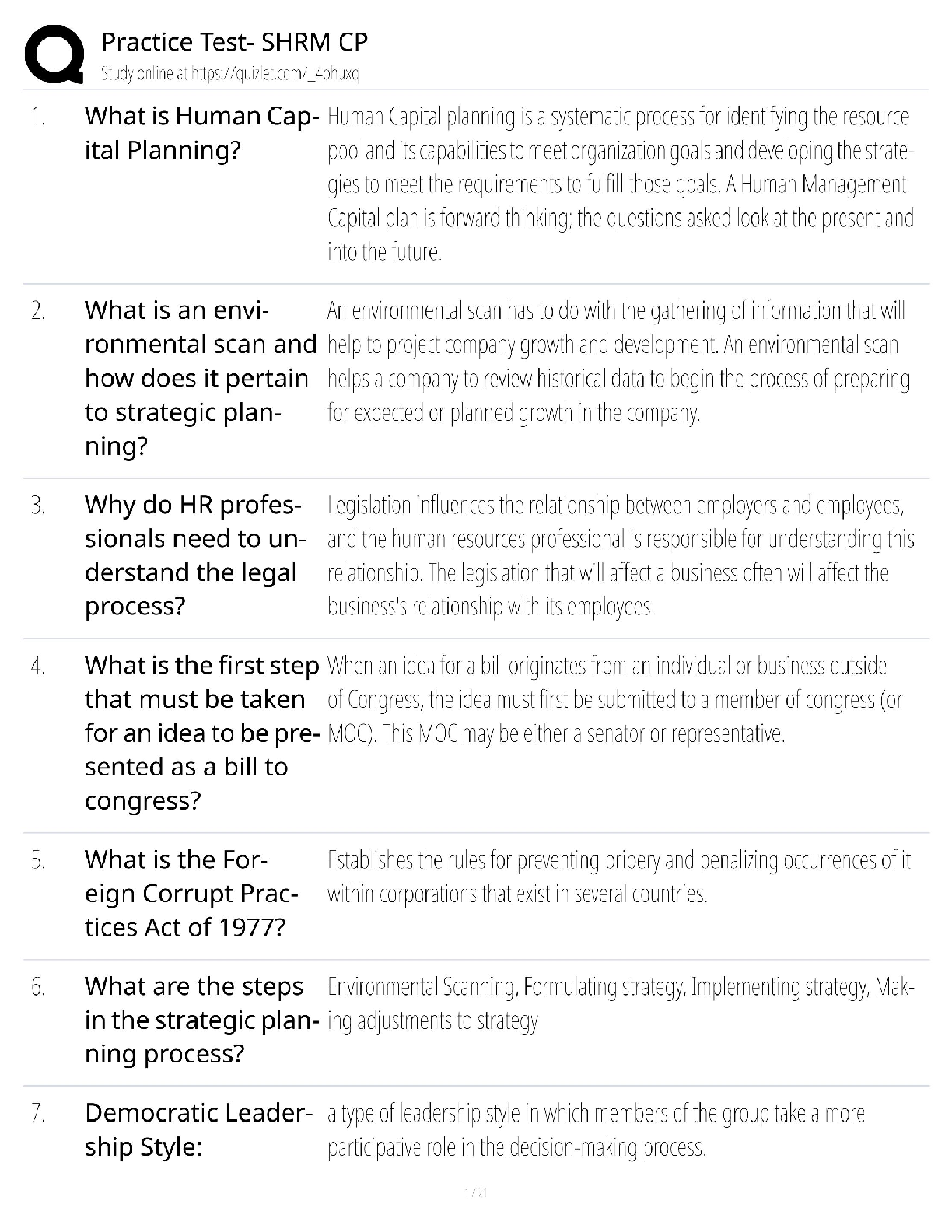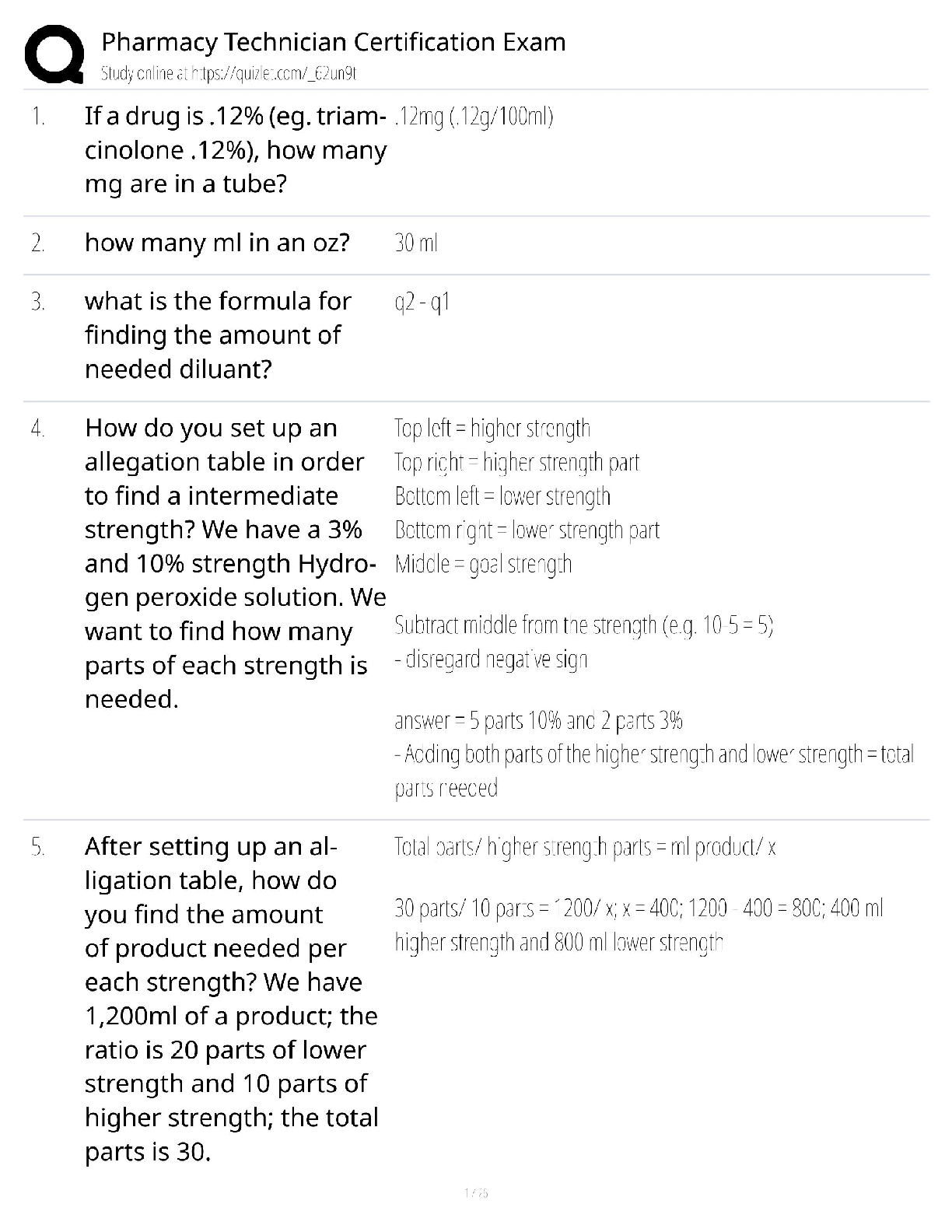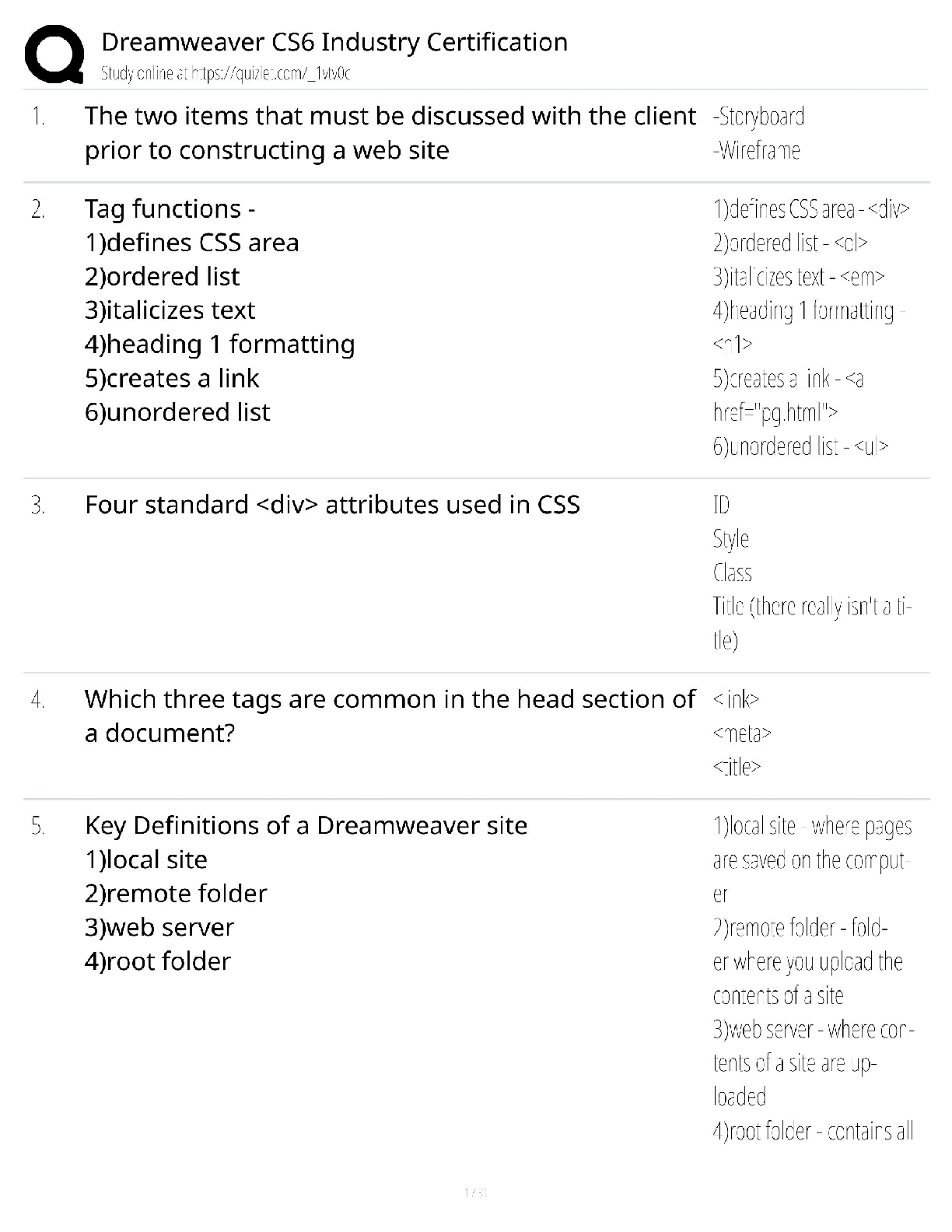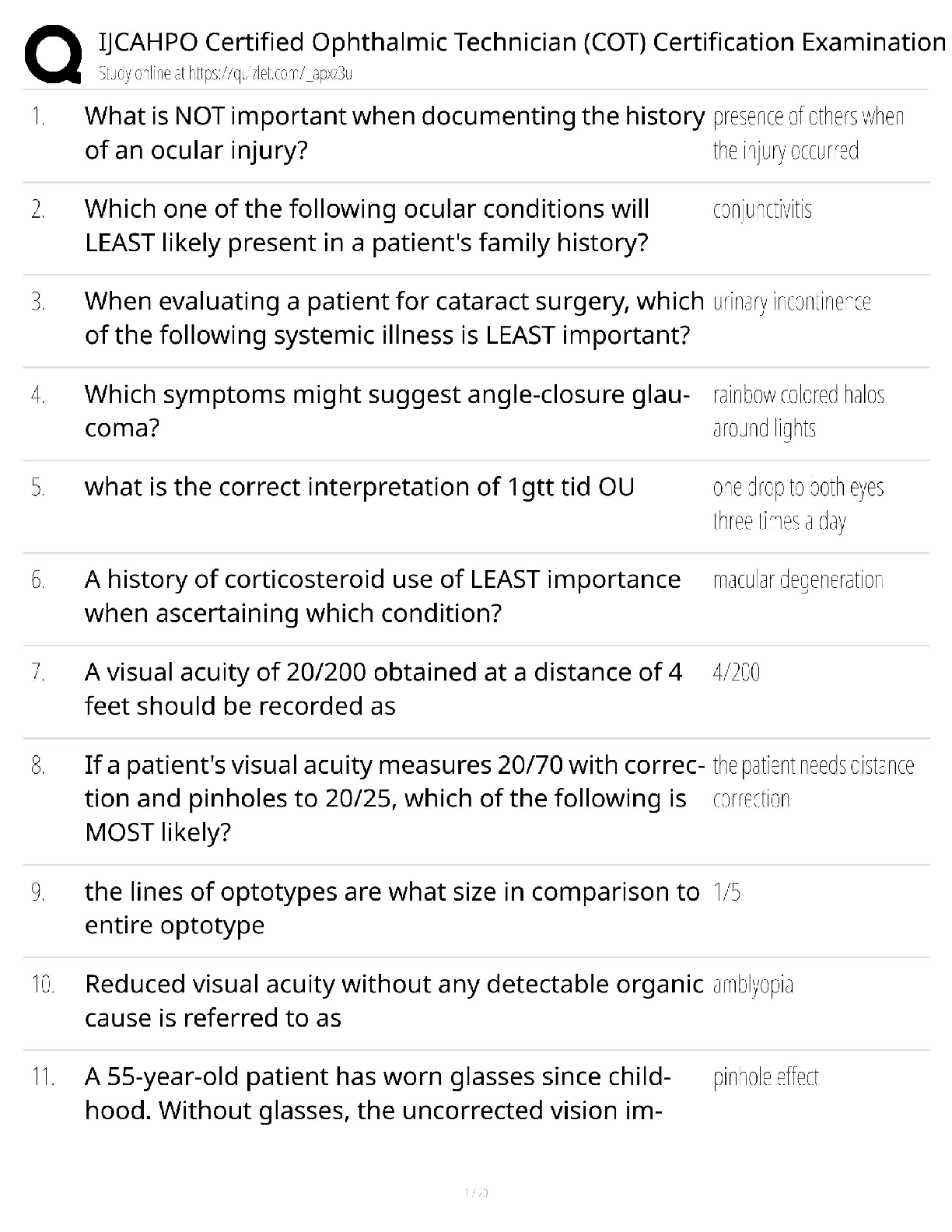CIS 321 Quiz bank Updated latest Questions & Answers.
Document Content and Description Below
CIS 321 QUIZ BANK
1. Question : (TCO 1) Which of the following is NOT one of the principles of systems development?
Use a problem-solving approach.
Divide and conquer.
Estab
...
lish phases and activities.
Establish standards for consistent development and documentation.
Leave the users alone until you have a product they can use.
2. Question : (TCO 1) The first CMM level at which a standard project methodology is practiced is
Level 1.
Level 2.
Level 3.
Level 4.
Level 5.
3. Question : (TCO 1) An information system that processes payroll checks would be an example of a(n)
TPS.
DSS.
MIS.
EIS.
expert system.
4. Question : (TCO 1) The title of those people whose jobs involve the creation, collection, processing, distribution, and use of information is
network manager.
information worker.
systems owner.
systems designer.
None of the above
5. Question : (TCO 1) The person who translates system users' business requirements and constraints into technical solutions is a
systems designer.
systems builder.
systems user.
network manager.
None of the above
6. Question : (TCO 1) A systems analyst who sells his or her expertise to other businesses is known as a(n)
ERP.
ESP.
EIS.
B2C.
scab.
7. Question : (TCO 1) Which of the following is a basic type of electronic-commerce-enabled application?
Marketing of corporate image, products, and services
Business-to-consumer commerce offering new channels of distribution
Business-to-business allowing the paperless and digital processing of business transactions between businesses
All of the above
None of the above
8. Question : (TCO 1) Which of the following methodologies uses small-scale, working models for users to react to?
Structured analysis
JAD
Prototyping
CASE
Information engineering
1. Question : (TCO 1) Data flow diagrams are used in
model-driven analysis.
traditional approaches.
structured analysis.
object oriented analysis.
A, B, and C
2. Question : (TCO 1) A description of features, characteristics, and constraints that define a satisfactory system but are not required in the initial version of the system is known as a
nonfunctional requirement.
functional requirement.
prototype.
physical requirement.
None of the above
3. Question : (TCO 1) A problem-solving technique that decomposes a system into its component parts while focusing on the business problem independent of technology is
systems design.
systems analysis.
cause-and-effect analysis.
joint application design (JAD).
None of the above
4. Question : (TCO 1) Which of the following is NOT a phase in systems analysis?
Scope definition phase
Implementation analysis phase
Requirements analysis phase
Decision analysis phase
None of the above
5. Question : (TCO 1) A description of activities and services that a system must provide is a
nonfunctional requirement.
functional requirement.
prototype.
physical requirement.
None of the above
6. Question : (TCO 3) Which of the following is NOT a project management cause of failed projects?
Shortcuts taken during the project
Lack of or imprecise targets
Inadequate systems analysis and design tools
Budget overruns
Schedule delays
7. Question : (TCO 3) Which of the following is NOT one of the 10 hints for project leadership?
Praise in public, criticize in private.
Explain and show, rather than do.
Don't rely just on status reports.
Keep "fudge" time in the schedule by not communicating real deadlines to team members.
Be consistent.
8. Question : (TCO 3) A tool for helping management understand the dynamics and impact of changing project parameters, such as cost, schedule, scope, and quality, is
total quality management.
project management.
joint project planning.
expectations management matrix.
None of the above
9. Question : (TCO 3) Which of the following functions of the project manager is the most difficult and important function?
Planning
Organizing
Directing
Controlling
Staffing
10. Question : (TCO 3) Which of the following establishes a project start date and then schedules forward from that date?
End scheduling
Remote scheduling
Forward scheduling
Reverse scheduling
None of the above
Comments
1. Question : (TCO 4) Something that the information system must do, or a property it must have, is called a
functional requirement.
nonfunctional requirement.
system requirement.
scope
None of the above
2. Question : (TCO 4) A technique for generating ideas during group meetings in which participants are encouraged to generate as many ideas as possible in a short time without any analysis until all ideas have been exhausted is known as
prototyping.
interviewing.
scribing.
brainstorming.
None of the above
3. Question : (TCO 4) The process of collecting a representative sample of documents, forms, and records is known as
sampling.
prototyping.
modeling.
patterning.
None of the above
4. Question : (TCO 5) A context data flow diagram
is a model with a scope from the designer's point of view.
is a model that breaks the system down into individual events.
identifies all external data stores, external agents, and processes.
None of the above
5. Question : (TCO 5) Logical models
remove biases that are the result of the way the current system is implemented.
reduce the risk of missing business requirements.
communicate with end users in nontechnical or less technical languages.
All of the above
None of the above
6. Question : (TCO 4) System requirements are also called
requirements discoveries.
problem analysis requirements.
business requirements.
preliminary requirements.
None of the above
7. Question : (TCO 4) An Ishikawa diagram is also referred to as a(n)
cause-and-effect diagram.
data flow diagram.
fishbone diagram.
entity relationship diagram.
Both A and C
8. Question : (TCO 5) Which of the following can most CASE tools not do?
Create process models
Check the completeness and accuracy of your models
Support all process model conventions
Allow easy modifications to reflect system changes
All of the above
9. Question : (TCO 5) In data flow diagrams
processes are represented by squares.
data flows are represented by open-ended boxes.
data stores are represented by arrows.
external agents are represented by rounded rectangles.
None of the above
10. Question : (TCO 5) A model that shows what a system is and what it does, as well as how it does it, is
a physical model.
a logical model.
a context model.
both a logical and a physical model.
None of the above
1. Question : (TCOs 9 and 10) Which defines what values an attribute can legitimately take on?
Realm
Entity
Relationship
Domain
None of the above
2. Question : (TCOs 9 and 10) Which of the following is a category of entities?
Person
Place
Object
Concept
All of the above
3. Question : (TCOs 9 and 10) Pointers to the records of a different file in a database; they are used to link records of one type to those of another type.
Attributes
Referential pointers
Descriptive fields
Foreign keys
None of the above
4. Question : (TCOs 9 and 10) The problem analysis phase model that includes only entities and relationships but no attributes
is known as the enterprise data model.
is known as the application data model.
is known as the context data model.
does not exist; all data models must have attributes.
None of the above
5. Question : (TCOs 9 and 10) A code that uses blocks of numbers that are divided into groups that have some business meaning is known as a
serial code.
hierarchical code.
significant position code.
block code.
None of the above
6. Question : (TCOs 9 and 10) The physical implementation of a data attribute, it is the smallest unit of meaningful data to be stored.
A field
A file
A record
A key
None of the above
7. Question : (TCOs 9 and 10) The number of entities that can participate in a relationship is known as
the domain of the relationship.
the cardinality of the relationship.
the degree of the relationship.
the association of the relationship.
None of the above
8. Question : (TCOs 9 and 10) An entity relationship diagram
is used in data modeling.
depicts data in terms of entities and relationships.
identifies the cardinality of a relationship.
makes clear the degree of a relationship.
All of the above
9. Question : (TCOs 9 and 10) An entity whose instances store attributes that are common to one or more entities is a
supertype.
subtype.
compound type.
default type.
None of the above
10. Question : (TCOs 9 and 10) The process that prepares a data model for implementation as a database is known as
contextualization.
normalization.
data analysis.
both normalization and data analysis.
None of the above
11. Question : (TCOs 9 and 10) An attribute whose value can be calculated from other attributes is called a
compound attribute.
derived attribute.
domain attribute.
false attribute.
None of the above
12. Question : (TCOs 9 and 10) The DeptID field in an employee table must match the DeptID of an existing record in the department table. This is an example of
key integrity.
domain integrity.
referential integrity.
logical integrity.
schema integrity.
13. Question : (TCOs 9 and 10) Students take courses and get grades. A Course can have many Students. A Student can take many Courses. For each course, the student gets a Grade. How would you define the relationship between Student and Course such that it is in 3NF?
an entity whose non-primary-key attributes are not dependent on any other non-primary-key attributes
1 of 4
The relationship between Student and Course is many to many. The Grade entity would be the associative entity between Student and Course. The Student would have Student number as a primary key. The Course would have Course number as the primary key. The Grade would have the combination of Course number and Student number as the primary key, with Student number and Course number also serving as foreign keys.
1. Question : (TCOs 5, 6, 7, and 9) A context data flow diagram
is a model with a scope from the designer's point of view.
is a model that breaks the system down into individual events.
identifies all data stores, external agents, and processes.
All of the above
None of the above
0 of 5
2. Question : (TCOs 5, 6, 7, and 9) The act of breaking a system into its component subsystems, processes, and subprocesses is known as
generalization.
normalization.
composition.
decomposition.
None of the above
5 of 5
3. Question : (TCOs 5, 6, 7, and 9) Logical models
remove biases that are the result of the way the current system is implemented.
reduce the risk of missing business requirements.
communicate with end users in nontechnical or less technical languages.
All of the above
None of the above
5 of 5
4. Question : (TCOs 5, 6, 7, and 9) In data flow diagrams
processes are represented by squares.
data flows are represented by open-ended boxes.
data stores are represented by arrows.
external agents are represented by rounded rectangles.
None of the above
5 of 5
5. Question : (TCOs 5, 6, 7, and 9) A model that shows what a system is and what it does but not how it does it is
a physical model.
a logical model.
a context model.
both a physical and logical model.
None of the above
5 of 5
6. Question : (TCOs 5, 6, 7, and 9) Another name for a data flow diagram is
a process model.
a transformation graph.
a bubble chart.
All of the above
None of the above
5 of 5
7. Question : (TCOs 5, 6, 7, and 9) Which of the following is a restriction of Structured English?
Only strong, imperative verbs may be used.
Only names that have been defined in the project dictionary may be used.
Formulas must be stated clearly using appropriate mathematical notations.
Blocking and indentation must be used for readability.
All of the above
5 of 5
8. Question : (TCOs 5, 6, 7, and 9) Gray holes are caused by
a misnamed process.
misnamed inputs.
incomplete facts.
All of the above
None of the above
5 of 5
1. Question : (TCO 2) Which of the following is NOT a technique for assessing economic feasibility?
Time value of money
Payback analysis
Return on investment
Net present value
All of the above are techniques for assessing economic feasibility.
2. Question : (TCO 2) Which of the following is NOT a guideline for answering questions during a formal presentation?
Limit the amount of time spent answering any one question.
Summarize your answers.
Try a little humor.
Never try to bluff.
Answer silly questions seriously.
3. Question : (TCO 2) Which kind of feasibility deals with deadlines?
Operational feasibility
Technical feasibility
Schedule feasibility
Legal feasibility
Cultural or political feasibility
4. Question : (TCO 2) The cost of the ability to invest in alternative projects rather than the project under consideration is known as
opportunity cost.
investment cost.
discount cost.
present cost.
None of the above
5. Question : (TCO 2) Which kind of feasibility can be impacted by government mandates?
Operational feasibility
Technical feasibility
Schedule feasibility
Legal feasibility
Cultural or political feasibility
6. Question : (TCO 6) Which of the following are examples of model-driven approaches?
Structured design, rapid application development, and CASE
Information engineering, CASE, and joint application design
Object-oriented design, joint application, and rapid application development
Structured design, information engineering, and object-oriented design
None of the above
7. Question : (TCO 6) Which of the following is an advantage of prototyping?
Prototypes are an active, not passive, model that end users can see, touch, feel, and experience.
Prototyping can increase creativity because it allows for quicker user feedback, which can lead to better solutions.
Prototyping accelerates several phases of the life cycle.
Iteration and change are a natural consequence of systems development. Prototyping better fits this natural situation because it assumes that a prototype evolves.
All of the above
8. Question : (TCO 6) Structured design seeks to factor a program into the top-down hierarchy of modules that have which of the following properties?
Loosely cohesive and highly coupled
Loosely cohesive and loosely coupled
Highly cohesive and highly coupled
Highly cohesive and loosely coupled
None of the above
9. Question : (TCO 6) A structure chart
is derived by studying the flow of data through the program.
is created during systems design.
does not address all aspects of design.
is the software model derived from structured design.
All of the above
10. Question : (TCO 6) When you have already decided on the specific product, but that product can be acquired from different vendors or distributors, what would you use to solicit a proposal from a vendor?
A equest for proposal (RFP)
A request for quotation (RFQ)
A request for specification (RFS)
A request for design (RFD)
None of the above
11. Question : (TCO 6) The information system application layer that implements any processing that must be done to generate the user interface is known as
the presentation layer.
the presentation logic layer.
the application logic layer.
the data manipulation layer.
the data layer.
12. Question : (TCO 6) Which of the following is represented in a physical data flow?
The planned implementation of an input to or output from a physical process
A database command or action, such as create, read, update, or delete
The import of data or the export of data to another information system across the network
The flow of data between two modules of subroutines within the same program
All of the above
13. Question : (TCO 6) A set of computers connected over a relatively short distance to one or more servers is known as a(n)
LAN.
WAN.
MAN.
CAN.
backbone.
14. Question : (TCO 6) A solution in which the data and data manipulation layers are placed on the server(s) and the application logic, presentation logic, and presentation are placed on the clients is known as
a distributed data client/server system OR multitiered client/server computing.
a distributed presentation client/server system OR multitiered client/server computing.
a distributed data client/server system OR two-tiered client/server computing.
a distributed presentation client/server system OR two-tiered client/server computing.
None of the above
15. Question : (TCO 6) Which of the following is NOT represented in a physical data flow?
The planned implementation of an input to or output from a physical process
A database command or action, such as create, read, update, or delete
The import of data or the export of data to another information system across the network
The flow of data between two modules of subroutines within the same program
Data and data manipulation layers being placed on the server(s) and the application logic, presentation logic, and presentation being placed on the clients
1. Question : (TCO 8) A term coined to collectively describe any information presented in a format other than traditional numbers, codes, and words, including graphics, sound, pictures, and animation, is
multimodal.
graphical.
zoned.
multimedia.
None of the above
2. Question : (TCO 8) The use of pictorial charts to convey information in ways that demonstrate trends and relationships not easily seen in tabular output is known as
zoned output.
scattered output.
pie charts.
graphic output.
None of the above
3. Question : (TCO 8) Paper is bulky and requires considerable storage space. To overcome the storage problem, many businesses use what other output medium?
Hyperlinks
Microfilm
Microfiche
Multimedia
Both B and C
4. Question : (TCO 8) Online processing is
the identification and acquisition of new data.
the process of collecting entered data into files called batches.
the process of translating the source document into a machine-readable format.
the immediate processing of captured data.
None of the above
5. Question : (TCO 8) Biometric ADC technology is
used on forms for objective-based questions on exams.
based on the use of radio frequency, a tag, and an antenna to identify and track physical objects.
most widely used in the banking industry.
based on unique human characteristics or traits—for example, fingerprints, voice patterns, and retinal patterns.
None of the above
6. Question : (TCO 8) Which of the following reports categorizes information for managers who do not want to wade through the details?
Summary
Exception
External
Detailed
None of the above
7. Question : (TCO 8) A text box
is most appropriately used when the input data values are unlimited in scope.
allows for single or multiple lines of data characters to be entered.
consists of a rectangular box that is usually accompanied by a caption.
should be accompanied by a descriptive, meaningful caption.
All of the above
8. Question : (TCO 8) Internal input controls
ensure that the data input to the computer are accurate.
ensure that the system is protected against accidental and intentional errors and abuse, including fraud.
monitor the number of inputs to prevent source documents from being misplaced, lost, or skipped.
Both A and B
All of the above
9. Question : (TCO 8) Smart cards
are used on forms for objective-based questions on exams.
use radio frequency, a tag, and an antenna to identify and track physical objects.
are most widely used in the banking industry.
are based on unique human characteristics or traits—for example, fingerprints, voice patterns, and retinal patterns.
represent a portable storage medium that contains a microprocessor, memory circuits, and a battery with the ability to store a massive amount of information.
10. Question : (TCO 8) Batch processing is
the identification and acquisition of new data.
the process of collecting entered data into files called batches.
the process of translating the source document into a machine-readable format.
the process of capturing data immediately.
None of the above
11. Question : (TCOs 11, 12, and 13) A system acceptance test addresses which level of acceptance testing?
Validation testing
Verification testing
Audit testing
Unit testing
A, B, and C
12. Question : (TCOs 11, 12, and 13) Which kind of testing is sometimes called alpha testing?
Audit testing
Unit testing
Validation testing
Stub testing
Verification testing
13. Question : (TCOs 11, 12, and 13) Which kind of testing runs the system in a live environment using real data?
Validation testing
Verification testing
Audit testing
Matrix testing
Litmus testing
14. Question : (TCOs 11, 12, and 13) Which kind of testing runs the system in a simulated environment using simulated data?
Validation testing
Verification testing
Audit testing
Matrix testing
Litmus testing
15. Question : (TCOs 11, 12, and 13) Which of the following systems conversion strategies involves operating the old and new system jointly over a period of time before a cutover to the new system is made?
Abrupt cut-over
Parallel conversion
Location conversion
Staged conversion
Partial conversion
[Show More]
Last updated: 11 months ago
Preview 5 out of 32 pages
